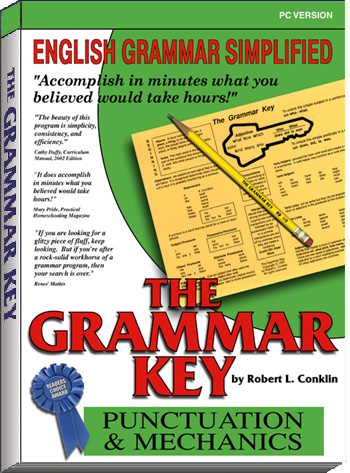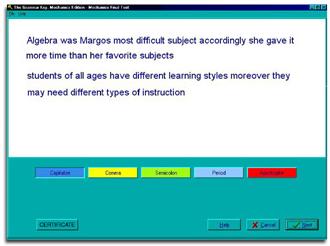The GrammarKey Sentence Structure & Parts of Speech CD | The GrammarKey Puncutation & Mechanics CD
The GrammarKey Workbook | The GrammarKey Card Pack | GrammarKey Diagram | View Video | Reviews
Research | FAQs | Pricing for Institutions | Pricing for Individuals
The Grammar Key
Punctuation & Mechanics CD

The Punctuation & Mechanics CD also offers over thirty narrated lessons and rounds out the instruction by taking students beyond the parts of speech to the application of rules.
How many times have you learned, after instructing a class in punctuation, how little they have actually understood, or for that matter, retained? Even a 70% passing grade suggests that students have failed to master 30% of the lesson. And if research holds true, they will forget over half those answers in only a few days. Consequently, you are caught in a vicious cycle of instruction, student work, correction, and further instruction.
With our Punctuation & Mechanics CD, those days are over. After the narrated text, students are taken step by step through each piece of information and then progressively challenged—without realizing it—to correct even the most difficult sentences. If they make a mistake (just as with the Sentence Structure & Parts of Speech CD), the program will inform them, at that precise moment, and then offer them clues to work toward the right answer.
Students are then encouraged to master 100% of the lesson while still grading their mistakes. You are spared the drudgery of checking and rechecking papers, and freed to do more creative work…to chisel and fine-tune writing skills and offer advice in "real world" writing and composition. Such freedom is normally experienced only by teachers of "Gifted Students."
|
Why Teach Grammar on a Computer? Since grammar is systematic, it can be taught on a computer, and since a computer never gets tired, it can repeat key words and grammatical patterns to the degree that they become internalized in the student’s mind. A computer can. |
|
What’s the difference between The Grammar Sentence Structure & Parts of Speech and The Grammar Key Punctuation & Mechanics? It might be helpful to examine the punctuation error in this sample sentence: "When students know the structure of a sentence and the parts of speech they have no problem grasping the rules of punctuation." You must also know the punctuation rule that states a comma always follows an introductory clause before the main clause begins. THIS IS WHAT WE TEACH IN THE GRAMMAR KEY PUNCTUATION & MECHANICS CD-ROM. Then the answer is simple: "When students know the structure of a sentence and the parts of speech, they have no problem grasping the rules of punctuation." |

Understanding of mechanics and punctuation of the English language is made simple with The Grammar Key.
